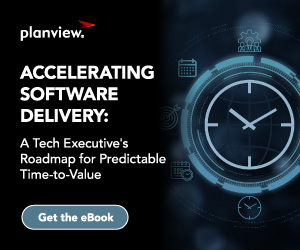
The development of digital products in today’s landscape is reshaping our daily lives and industries at an almost frenzied pace. Digital products are at the core of the transformations in every facet of our lives, from managing our finances and health to navigating transportation. This integration of digital solutions represents a significant shift in how we interact with technology and each other, creating new possibilities for efficiency in every aspect of life.
Digital product development is not merely a trend but a fundamental transformation in how businesses operate and innovate. This blog will delve into the common challenges in digital product development and discuss the necessity of a product operating model that leverages AI for better outcomes.
Capacity and Waste in Digital Product Development
Unlike in physical manufacturing, it is often difficult to visualize waste in digital product development. Yet, understanding and managing capacity and waste is crucial for optimizing efficiency and delivering value. Upon analyzing data from 49 organizations and over 6,400 value streams collected over the last five years, Planview found several key areas where capacity is often wasted, impacting overall productivity and effectiveness.
1. Misaligned Work and Strategic Objectives
One of the significant issues in capacity management is the misalignment of work with strategic objectives. Planview’s findings show that approximately 25% of capacity gets misaligned due to interruptions and unplanned work. This misalignment occurs early at the strategy planning stage, where teams anticipate that all their capacity will go towards achieving strategic goals. However, in reality, a quarter of their efforts are diverted to tasks that do not align with these objectives. This includes dealing with unexpected tasks and various interruptions that arise, consuming valuable resources and time.
Calculate how much of your capacity is being wasted on misaligned work with the Software Development Waste Calculator
2. Delivery Inefficiencies Caused By Bottlenecks and Overload
Delivery inefficiencies are another critical area where capacity is wasted. Teams commonly have interdependencies and take on too much work, creating bottlenecks and overload. Dependencies between teams cause significant delays, as work often sits waiting for other teams to complete their tasks. Additionally, when teams are overloaded with more work than they can handle, it slows down the entire system. These bottlenecks and overloads impede the smooth flow of work, causing delays and reducing the overall effectiveness of the development process.
3. Market Changes Impacting Delivered Value
Market changes can also significantly impact the value delivered by digital products. What starts as a competitive advantage in the planning phase often becomes merely a standard requirement by the time it is delivered. This shift happens because market conditions and customer expectations evolve rapidly, rendering initial innovations less impactful. As a result, companies may find that their products, which were initially designed to offer a competitive edge, end up only meeting basic market standards by the time they reach customers.
The Need for a Product Operating Model in Digital Product Development
Efficient digital product development is critical for modern enterprises to remain competitive and responsive to market demands. This journey involves adopting a comprehensive product operating model, leveraging advanced tools and methodologies, and integrating AI to enhance productivity and efficiency.
Coordinating complex, interdependent work is a cornerstone of successful digital product development. The product operating model is essential for managing this complexity, ensuring that various teams and processes align to create value. This model involves significant organizational changes beyond acquiring engineering skills, emphasizing value creation through coordinated efforts and effective portfolio management.
Key components of the product operating model include:
1. Managing Investments into Value Streams
Companies must allocate resources strategically to ensure maximum value creation. Solutions like Planview Viz play a crucial role in managing investments into value streams by providing visibility into how resources are allocated and utilized across different projects and initiatives. This tool tracks the flow of value, helping organizations ensure that investments are directed toward high-impact areas that align with strategic objectives.
Combined with an AI assistant like Planview Copilot, data can be automatically analyzed across the product development lifecycle, areas for investment can be identified, and potential risks can be flagged and mitigated.
2. Setting and Cascading Objectives
Objectives should be clearly defined and communicated throughout the organization to align efforts toward common goals. Strategic alignment through Objectives and Key Results (OKRs) drives decision-making from high-level strategic investments down to team-level execution. Visual tracking of OKRs enables transparency and alignment, ensuring that every team’s efforts contribute towards the organization’s strategic goals.
Planview Copilot can assist in tracking progress against these OKRs, ensuring that all work is aligned and teams consistently work towards the same desired outcomes.
3. Effective Planning and Adjusting
Continuous planning and adjustment are crucial to responding to changing market conditions and internal dynamics. Roadmapping software like Planview Roadmaps provides a visual representation of an organization’s plans, making it easy to adjust and pivot as needed. These solutions help maintain a clear view of delivery plans and milestones, ensuring the organization can respond quickly to changes. They also provide real-time visibility into dependencies between different initiatives, making it easier to identify and react to potential roadblocks.
Combined with an AI assistant, historical data can easily be analyzed to identify trends that can inform future planning. It can also suggest alternative approaches based on real-time data and insights.
4. Visualizing and Optimizing Workflow
Visualizing and optimizing the workflow is critical to identify and eliminate inefficiencies. Value stream analytics solutions like Planview Viz are instrumental in this area, as they track business-centered Flow Metrics and provide insights into where bottlenecks and overloading occur. By focusing on outcomes rather than activities, organizations can obtain real-time insights to optimize their team workflows and improve overall efficiency. They can also be used to track progress on work items and measure the effectiveness of different work management practices. AI-driven insights from Planview Copilot further enhance this process by identifying areas for improvement and suggesting actions to resolve issues.
Leverage Advanced Tools to Enhance Digital Product Development Productivity
Maximizing efficiency in digital product development requires a strategic and holistic approach. By addressing the challenges of capacity management, aligning work with strategic objectives, and leveraging advanced platforms, solutions, and methodologies, organizations can significantly enhance their productivity and value delivery. A robust product operating model that incorporates AI-driven insights is essential for coordinating complex work, optimizing workflows, and responding to rapidly changing market conditions.
Investing in tools like Planview Viz, Planview Roadmaps, and AI assistants such as Planview Copilot can transform the development process. These solutions provide visibility, enhance decision-making, and streamline operations, ensuring that resources are allocated effectively and that teams are aligned with organizational goals. As digital products continue to reshape industries and daily life, adopting these best practices and technologies will be crucial for businesses aiming to stay competitive and innovative in the digital age.
Uncover productivity roadblocks and hidden sources of waste with the Software Development Waste Calculator.




